BBC Television Centre
| BBC Television Centre | |
|---|---|
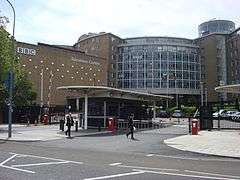 Was one of the largest such facilities in the world | |
 Location within Greater London | |
| General information | |
| Type | Television broadcast facilities |
| Architectural style | Minimalist |
| Location | West side of Wood Lane (A219) in White City, opposite Wood Lane tube station |
| Address | White City, W12 7RJ |
| Country | United Kingdom |
| Coordinates | 51°30′36″N 0°13′35″W / 51.5099°N 0.2263°WCoordinates: 51°30′36″N 0°13′35″W / 51.5099°N 0.2263°W |
| Elevation | 6 m (20 ft) |
| Completed | 29 June 1960 |
| Inaugurated | 29 June 1960 |
| Renovated | 2013–15 (due to be complete by 2020) |
| Closed | 31 March 2013 (BBC reopening September 2017) |
| Demolished | May 2015 |
| Cost |
£10m adjusted by inflation: £109m |
| Owner |
BBC (1960–2012) Stanhope plc (2012–present) |
| Technical details | |
| Floor count | 8 (above ground) |
| Floor area | 14 acres (5.7 ha) |
| Design and construction | |
| Architect | Graham Dawbarn |
| Architecture firm | Norman & Dawbarn |
| Structural engineer | Mr Marmaduke T Tudsbery |
| Main contractor | Higgs and Hill (superstructure), George Wimpey (foundations) |
The BBC Television Centre at White City in west London was the headquarters of BBC Television between 1960 and 2013. Officially opened on 29 June 1960, it is one of the most readily recognisable facilities of its type, having appeared as the backdrop for many BBC programmes. Parts of the building are Grade II listed, including the central ring and Studio 1. Most of the BBC's national television and radio news output came from the Television Centre (TVC) with most recorded television output from the nearby Broadcast Centre at 201 Wood Lane, care of Red Bee Media. Live television events from studios and routing of national and international sporting events took place within the Television Centre before being passed to the Broadcast Centre for transmission.
It was announced on 21 September 2010 that the BBC would cease broadcasting from Television Centre in 2013.[1] On 13 June 2011 the BBC announced that the Television Centre was on the market, and that it was "inviting bid proposals from people looking for a conventional, freehold property or those interested in a joint venture", suggesting that it may yet remain connected to the BBC.[2]
On 16 July 2012 it was announced that the complex had been sold to property developers Stanhope plc for around £200 million and that the BBC would retain a continued presence at Television Centre through its commercial subsidiaries BBC Studios and Post Production, and BBC Worldwide. BBC Studios and Post Production (relocated to Elstree Studios) was due to move back to Television Centre to operate Studio 1, 2 and 3 in 2015, but it was announced in July 2014 that it had agreed with Stanhope to move back in 2017, at the same time as other key tenants, to enable the most efficient overall site construction programme to take place.[3] BBC Worldwide moved into office space in the Stage 6 building following extensive refurbishment in 2015.[4]
The radio and television news departments moved to Broadcasting House in central London, the home of BBC Radio, as part of a reorganisation. BBC News moved to new facilities in Broadcasting House on 18 March 2013, but TVC remained in active use with many programmes being taped in the studios until it closed for redevelopment officially on 31 March 2013. BBC TVC was one of the largest such facilities in the world and was the second-oldest operational television studio in the United Kingdom, after Granada Studios where the BBC's main commercial rival, Granada Television, was based for many decades.[5]
Developers Stanhope said in April 2014 that the new Television Centre development would "pay homage to the original use of the building" and retain original features of the buildings including the "doughnut", atomic dot wall and Helios statue.[6] The new Television Centre will be opened up to the public and will offer entertainment and leisure facilities, including a new branch of members' club Soho House, offices aimed at the creative sector and approximately 1,000 new homes, together with pedestrian access through the site providing connectivity with the local area, including Hammersmith Park.[7][8]
The building is 4 miles (6 kilometres) west of central London. The nearest Underground stations are White City and Wood Lane.
History
On Friday 1 April 1949 Norman Collins, the Controller of the BBC Television Service, announced at the Television Society's annual dinner at The Waldorf Hilton, London that a new TV centre would be built in Shepherd's Bush. London broadcasts at the time came from Alexandra Palace and Lime Grove Studios (from 1949). It was to be the largest television centre in the world.[9] Riverside Studios in Hammersmith were used from 1954.[9]
It was planned to be 6 acres (2.4 hectares), but turned out to be twice as big. On 24 August 1956 the main contract was awarded to Higgs and Hill, which also built The London Studios for ITV in 1972. The building was planned to cost £9M.[9]
When it opened, the Director of BBC television was Gerald Beadle, and the first programme broadcast was First Night with David Nixon in Studio Three.[10]
In 1997 the BBC News Centre was opened, in a new complex at the front of the building.[11] The decision to move radio news to this building was attributed to Director General John Birt, a move that was resisted by the managing director of BBC Radio, Liz Forgan, who resigned after failing to dissuade the governors. Birt's decision caused problems; for example some politicians accustomed to travelling to interviews at Broadcasting House were reluctant to make the journey to White City, despite being only 4 1⁄2 mi (7.2 km) west.
The building
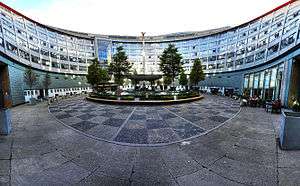
Circular shape
The building featured a central circular block (officially known as the Main Block, but often referred to by staff as the "doughnut") around which were studios, offices, engineering areas and the News Centre. In the centre of the main block was a statue designed by T.B. Huxley-Jones of Helios, the Greek god of the sun, to symbolise the radiation of television around the world. At the foot of the statue were two reclining figures, symbolising sound and vision, the components of television. It was originally a fountain, but owing to the building's unique shape it was too noisy for the staff in the overlooking offices, and there were problems with water leakage into the videotape area directly beneath. Even though there was a foundation stone marked 'BBC 1956' in the basement of the main building, construction began in 1951.[12] Various extensions have been added.
Increasingly the BBC had to seek accommodation elsewhere, such as the nearby BBC White City complex comprising White City One, a 25,000 square metre office building, and the adjacent Broadcast and Media Centres. With the migration of staff and functions to complexes in Salford and London W1, White City One was mothballed in March 2013.
Design
The overall design from the air appeared to resemble a question mark in shape. The architect, Graham Dawbarn CBE (Norman & Dawbarn), drew a question mark on an envelope (now held by the BBC Written Archives Centre) while thinking about the design of the building, and realised that it would be an ideal shape for the site.[13] An article in The BBC Quarterly, July 1946, proposed a circular design, several years before Dawbarn drew up his plans.
The building was commissioned in 1949 with work starting in 1950. However government restrictions on building, through its loan sanction and licensing of materials, ensured that building was halted until 1953 so the BBC remodelled the former Gaumont Studios at Lime Grove, the Riverside Studios in Hammersmith and in 1953, Shepherd's Bush Empire. Work resumed in 1953 on the TVC scenery block (Stage 1) and work began in 1954 on the canteen block (Stage 2), which doubled as a rehearsal space.
Work on Stage 3, the central circular office block and studios, began in March 1955 on TC4, 5 and 2. The shells of TC1, TC6 and TC7 were constructed around the same time but they were not fitted out until a few years later. BBC Television Centre officially opened with TC3 operational on 29 June 1960.[14]
Arthur Hayes worked on the building from 1956 to 1970 and was responsible for the creation of the iconic 'BBC Television Centre' lettering on the façade of Studio 1. The lettering was later used all over the building, even in tile work outside lift entrances. Demands from Broadcasting House meant that Hayes had less time than he had thought to design a decor for the façade, leading to him puncturing a scale foam model of the wall with drawing pins, and thus the birth of the iconic 'Atomic Dots': there are 26 across the façade of Studio 1, each one backlit and clearly visible at night.
Infrastructure
In February 1996, the electricity and heating were transferred to a European Gas Turbines (EGT) 4.9MWe Typhoon gas turbine combined heating, power and cooling unit.[15] It included a 6MW Thermax air conditioning (cooling) vapour absorption machine (VAM). The £6m HVAC system reduced energy costs by 35%, and paid for itself within three years. A second turbine was added, without a second chimney. However, in 2008[16] the BBC admitted that the energy system was being used for emergency purposes only as it had become cost-ineffective to use full-time. Excess electricity produced at night has not been returned to the National Grid, as originally planned. In November 2003, the turbine's chimneys caught fire,[17] bringing TV output to a halt. After the fire the turbines were no longer used regularly.
Listed status
The development of the Westfield shopping centre nearby led to a sharp rise in property prices and placed the Television Centre under threat. In February 2008, with an amendment in November, English Heritage requested listed status for the scenery workshop, the canteen block adjoining the Blue Peter Garden, and the central building.[18] Previously, under a longstanding deal between the BBC and English Heritage the building was not listed to allow the BBC to make changes necessary in a broadcasting centre. In return, the BBC agreed that if it left, the fabric of the building would be restored to its mid-60s state, and English Heritage would list notable features.[19]
On 17 June 2009 the Central Ring of the building and Studio 1, noting in particular the John Piper mosaic, central drum with its mosaic tiles, the Huxley-Jones gilded statue of Helios, full-height glazing of the stair and original clock in the Central Ring, received Grade II listed status from the Department for Culture, Media and Sport.[20] The 'atomic dots' and name of Studio 1, and the cantilevered porch on its exterior were noted as important architectural features of that building.[21] The Department did not consider the other buildings, including all other studios, scenery block and canteen of sufficient special interest to warrant listing.[21][22] Making the protection announcement, the architecture minister Barbara Follett noted that it was where Doctor Who, Fawlty Towers and Blue Peter were made: "It has been a torture chamber for politicians, and an endless source of first-class entertainment for the nation—sometimes both at the same time."[22]
Future uses
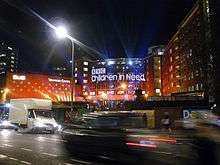
It was announced on 18 October 2007 that in order to meet a £2 billion shortfall in funding, the BBC intended to "reduce the size of the property portfolio in west London by selling BBC Television Centre by the end of the financial year 2012/13",[23] with the then Director General, Mark Thompson, saying the plan would deliver "a smaller, but fitter, BBC" in the digital age.[24] A BBC spokeswoman has added that "this is a full scale disposal of BBC Television Centre and we won't be leasing it back".[25] The corporation officially put Television Centre on the property market in November 2011.[26][27]
BBC Sport and BBC Children's moved to MediaCityUK in Salford Quays in 2012,[28] with Children's Learning, Radio 5 Live[29] and part of BBC Future Media & Technology.[30] The move saw up to 1,500 posts at TV Centre and 700 posts at New Broadcasting House relocate to Salford Quays. BBC Breakfast, part of BBC News, moved to Salford in April 2012.[31][32]
On 16 July 2012, the BBC agreed to sell the site to Stanhope plc for £200 million.[33] The building closed on 31 March 2013 and will be redeveloped to include flats, office space, a cinema and hotels.[34] Studios 1, 2 and 3 along with part of the basement and offices will be refurbished and leased back to the BBC on a 15-year lease.[35] The original schedule would have seen Studios 1, 2, & 3 back in production by Autumn of 2014 however on 17 July 2014 the BBC announced that due to the extensive building work, programme production will not recommence at Television Centre until 2017 when much of the demolition and groundwork has been completed.[36] The BBC's commercial businesses, BBC Worldwide and BBC Studios and Post Production will lease back Stage 6 as office space which is the part formerly occupied by BBC News.[37]
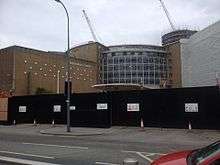
All BBC News, national radio and BBC World Service broadcasts were relocated to Broadcasting House between July 2012 and March 2013, which is said to include one of the largest live newsrooms in the world.[38] The final news broadcasts from Television Centre took place on 18 March 2013, when the BBC News channel and remaining news output completed the move to Broadcasting House. This was one of the final live broadcasts from the building.[39]
A 90-minute documentary titled Tales of Television Centre[40] was broadcast on BBC Four in 2012 ahead of the move out. On 22 March 2013, BBC Four devoted its evening schedule to programmes commemorating Television Centre. At the heart of the evening was Goodbye Television Centre a two-hour history presented by former BBC One controller and BBC chairman Michael Grade. The last live programme broadcast was Madness Live: Goodbye Television Centre, shown that day on BBC Four.
In March 2013, the BBC and Stanhope formed a joint venture, Television Centre Developments, to manage the redevelopment of the 14-acre site.[41] Only three of the eight production studios were earmarked for continued use by the BBC, with the rest being demolished for flats, and it was argued that this would leave insufficient facilities in the capital for independent television production, and a Save Television Centre Studios website and petition was set up.
In December 2013 Stanhope was granted planning permission from the London Borough of Hammersmith and Fulham.[42]
In October 2014, UK magazine Private Eye reported that having spent £60 million to remove broadcasting equipment from the building, the BBC planned to spend £12 million a year to lease back parts of the building.[43] This decision was in direct contradiction of the BBC’s promise in 2007 that the sale of TVC was a “full-scale disposal” and that it would not be leasing back any part of the building.[44]
Demolition work began in February 2015.[45]
As of April 2016 only Studios TC1, TC2 and TC3 remain, the other studios TC4, TC5, TC6, TC7 and TC8 have now all been demolished. The statue of Helios, the Greek God of Sun, has been removed for renovation before it returns to pride of place at the redevelopment at Television Centre later in 2016. Developer Stanhope and construction manager Mace have carefully removed the gilded bronze figure with heritage experts PAYE Conservation for repair and renovation. The Helios has stood in the rotunda at Television Centre since the former BBC headquarters opened in 1960.[46]
BBC Studioworks, the commercial subsidiary of the BBC who will operate and maintain the newly refurbished Studios 1, 2 and 3 and production facilities at Television Centre have confirmed on their website that the newly refurbished Television Centre studios, productions facilities and post production facilities will have its official opening in September 2017.[47]
Major events

Terrorist target
On 4 March 2001, a bomb placed outside the news centre exploded, with no fatalities.[48] It was attributed to the Real IRA and the culprits were eventually caught. The front of the building suffered moderate damage, but was soon repaired.
Power failures
Television Centre has suffered from power cuts that affected normal broadcasting, but these were not seen as a systemic problem. One such power cut caused the launch night of BBC2, on 20 April 1964, to be cancelled; programmes began the next day.[49]
A large power failure occurred on 20 June 2000 at approximately 5pm, affecting the whole Television Centre resulting in services such as BBC Two and BBC Radio 4 coming off air, and BBC News 24 went off air before being relocated to the BBC's Westminster studios. The Six O'Clock News suffered severe lighting problems and had to be cancelled halfway through, and the BBC's backup generator caught fire. Troubles were experienced in the South East region, as Newsroom South East started later than planned. The fire alarms went off at Television Centre later that day, leaving only a skeleton crew. Eventually many programmes returned, from different locations: Newsnight was presented from the main news studio with intermittent technical problems. The failure was due to a substation in Shepherd's Bush and normal services resumed the following day.[50]
Just before 8am on 28 November 2003 an electrical fault caused some equipment to overheat, which set off fire alarms.[17] Although there was no fire, the fault caused widespread power cuts and prevented backup generators from providing alternative power. All output was affected with services transferred across London to alternative studios. The One O'Clock News and BBC News 24 broadcast for much of the day from the BBC's Millbank Studios,[17] and the Today programme and Five Live's Breakfast morning radio shows fell off air for 15 minutes.[17] The Millbank Studios are a fall-back for news operations in the event of TVC failure, and are continually recording the last hour of the BBC News Channel output (sans in-vision clock) for this purpose. This power cut came on the week prior to the relaunch of News 24, which was postponed for another week to ensure that all problems had been remedied.[51]
Protests
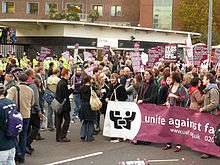
Programmes have been interrupted by protesters gaining access to Television Centre. In 1988, a group of lesbian protestors campaigning against Section 28 of the Local Government Act 1988 gained access to the studio of the Six O'Clock News during a live broadcast.[52] Newsreader Sue Lawley continued with the broadcast, while co-presenter Nicholas Witchell tackled the intruders off-camera.[53]
On 20 May 2006 during the live broadcast of National Lottery: Jet Set the studio was invaded by members of the Fathers 4 Justice campaign group, causing the show to go briefly off air while the protesters were removed.[54] This was also a problem as that night's lottery broadcast ran straight into the Eurovision Song Contest 2006.
For Question Time on 22 October 2009, the BBC invited the leader of the British National Party, Nick Griffin, onto the programme for the first time causing heated public debate and strong protests outside the studios.[55] Television Centre had its security breached with around 30 anti-fascist protesters storming the reception area and several hundred protesters gathering outside. Police and security staff were forced to close gates leading into the Centre and form barriers to prevent any further breaches of security.[56]
References
- ↑ BBC1 to go live for coronation anniversary night in 2013, guardian.co.uk, 21 September 2010
- ↑ "BBC Television Centre up for sale" (video). BBC News. 13 June 2011.
- ↑ "Televisual – NEWS & COMMENTS". televisual.com. Retrieved 21 February 2015.
- ↑ "BBC, Stanhope Plc and Mitsui Fudosan complete sale of Television Centre". bbc.co.uk. Retrieved 21 February 2015.
- ↑ "Dyke accused of conflict of interest over £6m holding in rival TV firm". The Independent. 17 January 2000.
- ↑ "New TVC plans include rooftop pool". broadcastnow.co.uk. Retrieved 21 February 2015.
- ↑ "Television Centre". television-centre.com. Retrieved 21 February 2015.
- ↑ John Reynolds. "BBC Television Centre redevelopment to include branch of Soho House". The Guardian. Retrieved 21 February 2015.
- 1 2 3 BBC Television Centre – History
- ↑ "BBC Television Centre up for sale". BBC News. 13 June 2011. Retrieved 14 March 2012.
- ↑ "About BBC News – 1990s". BBC News. Retrieved 14 March 2012.
- ↑ Kempton, Martin. "An Unofficial History of BBC Television Centre". History of Television Studios in London. Archived from the original on 7 September 2007. Retrieved 7 September 2007.
- ↑ "Television Gets A Complex". Transdiffusion – EMC Studio One). 1 January 2005. Archived from the original on 29 June 2007. Retrieved 21 June 2007.
- ↑ Kempton, Martin. "An Unofficial History of BBC Television Centre". History of Television Studios in London. Retrieved 23 July 2012.
- ↑ "EGT Typhoon" (PDF). Energy Solutions Center. Retrieved 21 September 2010.
- ↑ Tara Conlan (18 July 2008). "BBC 'wasted £6m on gas turbines'". guardian.co.uk. Guardian News and Media. Retrieved 21 September 2010.
- 1 2 3 4 "BBC 'chaos' as TV Centre hit by power cut". The Guardian. 28 November 2003.
- ↑ ""Auntie" honoured in recommendation to list parts of BBC Television Centre". Archived from the original on 1 July 2008. Retrieved 2 July 2008.
English Heritage has advised the Minister for Culture Media and Sport to recognise the extraordinary cultural and architectural significance of BBC Television Centre at White City, Wood Lane, London, and list parts of it at grade II
- ↑ BECTU newsletter BBC Informer, July 2008
- ↑ Historic England. "Details from listed building database (1393371)". National Heritage List for England. Retrieved 12 June 2011.
- 1 2 English Heritage (Listing) Adviser's Report BD Online, 22 June 2009
- 1 2 "Grade II listing for BBC Television Centre". BD Online. Building Design. 10 July 2009. Retrieved 21 September 2010.
- ↑ "Radical reform to deliver a more focused BBC". BBC Press Office. 18 October 2007. Archived from the original on 20 October 2007. Retrieved 18 October 2007.
- ↑ "BBC cuts back programmes and jobs". BBC News. 18 October 2007. Archived from the original on 20 October 2007. Retrieved 18 October 2007.
- ↑ "BBC shuns headquarter sale-and-leaseback". Reuters. 18 October 2007. Retrieved 23 October 2007.
- ↑ "BBC Television Centre up for sale". BBC News. 13 June 2011. Retrieved 28 November 2011.
- ↑ "For the love of Television Centre". BBC News. 14 June 2011. Retrieved 28 November 2011.
- ↑ Queen opens BBC's new base in Salford BBC News, 23 March 2012
- ↑ The BBC's outlook for Salford is sunny The Telegraph, 29 October 2011
- ↑ "BBC move to Salford gets green light". BBC Press Office. 31 May 2007. Retrieved 23 October 2007.
- ↑ BBC Breakfast moves to Salford BBC Press Office, 14 July 2010
- ↑ BBC Breakfast makes Salford move BBC News, 10 April 2012
- ↑ Robert Dex (16 July 2012). "BBC Television Centre sold for £200m". The Independent. Retrieved 29 December 2012.
- ↑ Kane, Chris. "BBC – Spaces & Places: Television Centre – shaping the next chapter". Retrieved 2 July 2016.
- ↑ "history of television studios in London". Retrieved 2 July 2016.
- ↑ "BBC News – Television Centre return delayed by two years". BBC News. Retrieved 21 February 2015.
- ↑ "BBC TV Centre to broadcast last network news bulletins". BBC News. 17 March 2013. Retrieved 17 March 2013.
"BBC TV Centre: viewers offered chance to buy slice of landmark building". The Guardian. 5 February 2013. Retrieved 22 March 2013.
The Masterplan, television-centre.com (Redevelopers' official website) - ↑ The story of Broadcasting House BBC
- ↑ "BBC News' television output moves to new studios at Broadcasting House". BBC. 2013-03-18. Retrieved 2013-03-18.
- ↑ Tales of Television Centre at the Internet Movie Database
- ↑ "Welcome to the Television Centre website". Television Centre Developments. 2013. Retrieved 18 May 2013.
- ↑ "BBC TV Centre plans approved". lbhf.gov.uk. Retrieved 21 February 2015.
- ↑ "Media News". Private Eye. London. 17 October 2014. p. 12.
- ↑ Kemble-Diaz, William (18 October 2007). "BBC shuns headquarter sale-and-leaseback". Reuters (UK). Retrieved 16 October 2014.
- ↑ Harris, Simon (23 February 2015). "Phillip Schofield slams 'criminal' selling of iconic BBC TV Centre". ITV News. Retrieved 23 February 2015.
- ↑ "Television Centre – White City, London". 1 July 2016. Retrieved 2 July 2016.
- ↑ "BBC Studioworks – inside a refurbished Television Centre". 30 January 2016. Retrieved 2 July 2016.
- ↑ "Bomb blast outside BBC". BBC News. 4 March 2001. Retrieved 18 May 2012.
- ↑ Briggs, Caroline (20 April 2004). "BBC Two Launch Night". BBC News. Retrieved 14 March 2012.
- ↑ "Power cut hits BBC TV and radio". BBC News. 20 June 2000. Retrieved 14 March 2012.
- ↑ "Power cut halts channel relaunch". Scotsman.com. 29 November 2003.
- ↑ "When gay became a four-letter word". BBC News. 20 January 2000. Retrieved 1 December 2013.
- ↑ Freeman, Simon (31 March 2005). "Witchell, the BBC man who 'sat on a lesbian'". The Times. Retrieved 1 December 2013.
- ↑ "Lottery show delayed by protest". BBC News. 20 May 2006. Retrieved 15 August 2012.
- ↑ Gabbatt, Adam (22 October 2009). "BNP on Question Time". guardian.co.uk. Guardian News and Media. Retrieved 21 September 2010.
- ↑ "Angry scenes face Griffin at BBC". BBC News. 22 October 2009. Retrieved 26 April 2010.
External links
| Wikimedia Commons has media related to BBC Television Centre. |
- Television Centre W12 official redevelopment website
- Television Centre BBC Press Office, May 2004
- BBC TV Centre sale looks unlikely guardian.co.uk, 5 March 2008
- Future of BBC TV Centre in doubt BBC News, 11 January 2007
- BBC Television Centre may be sold for £300m The Telegraph, 13 October 2007
- Decision to sell BBC Television Centre signals end of an era Mail Online, 18 October 2007
- BBC icon for sale? TechWatch, 6 March 2008
- Row brewing over listing of BBC Television Centre guardian.co.uk, 27 June 2008
- BBC Television Centre sale at risk as English Heritage considers listed status The Telegraph, 29 June 2008
- Listed status bid for BBC centre BBC News, 29 June 2008
- Unofficial History of BBC Television Centre TV Studio History
- Tales of Television Centre on YouTube commemorative documentary broadcast 15 May 2012, followed by Q&A session with producer/director Richard Marson
- GES046 – BBC TV Centre (Trip 1) Guerrilla Exploring, Unofficial Insider Tour – A look around the building and behind the scenes
| Preceded by Villa Louvigny Luxembourg City |
Eurovision Song Contest Venue 1963 |
Succeeded by Tivolis Koncertsal Copenhagen |
| Preceded by first venue |
Eurovision Dance Contest Venue 2007 |
Succeeded by SECC Glasgow |